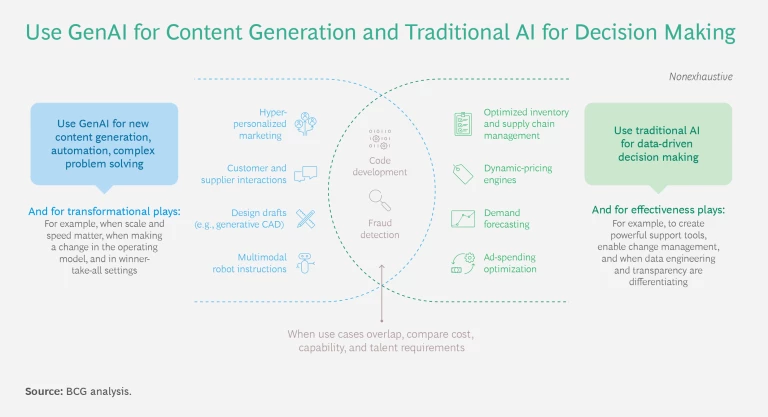As generative AI (GenAI) reshapes customer experience , forward-thinking leaders are focusing on how to turn its vast potential into measurable business value. Rather than succumbing to shiny-object syndrome or diluting efforts across too many initiatives, decision makers need a strategic approach to GenAI deployment.
Many are under acute pressure to demonstrate that they are on the vanguard—and not the sidelines—in using this powerful technology. Because GenAI is so new, however, many leaders don’t know which applications have the most value-generating potential for their business and what it will take to execute them.
Drawing on BCG’s extensive work with GenAI in customer service,
marketing
, and sales, we’ve discovered practical strategies that can help leaders pivot away from whacking things with a hammer and start building a more powerful GenAI capability.
Redefine the Economics of Experience with These Three Use Cases
GenAI has the potential to support dozens of initiatives. But we recommend focusing on three main areas to get the greatest—and fastest—impact. (See Exhibit 1.) Concentrating GenAI in these areas can transform the customer journey and deliver massive benefits. (See Exhibit 2.) The following use cases provide a flavor of what that transformation can look like.
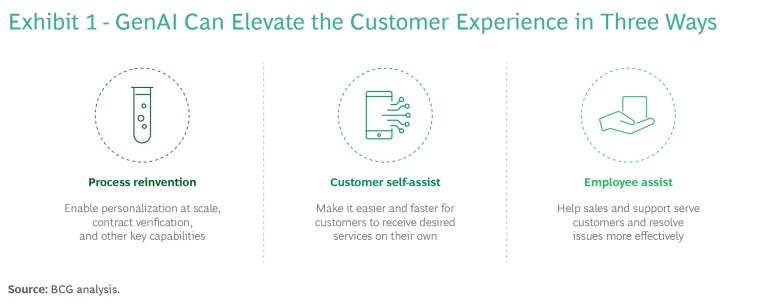
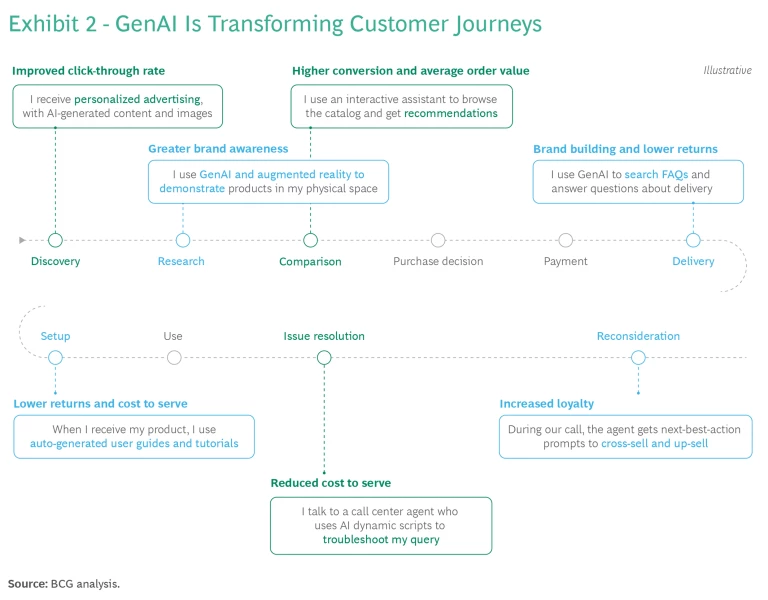
Process Reinvention—Making Personalized Discovery Achievable and Affordable. Hyper-personalization has been a longstanding aspiration for most marketers. But one-to-one marketing has been costly and complicated to put into practice, especially for large organizations with huge customer bases. An automaker, for instance, would have to program billions of experiences to launch a personalized marketing campaign. Text forms would need to be customized to the customer’s vehicle color and trim level and further tailored using consumer demographics such as an individual’s life stage, interests, and geographic area. The exponential scale of this challenge has meant that personalizing to markets of one was infeasible—until now.
GenAI reduces the complexity and time required to individualize messaging. The technology can pull data from multiple sources to define personas, tag existing content libraries to combine relevant imagery and content, load page builders, and use A/B tests to continually improve performance. (See Exhibit 3.)
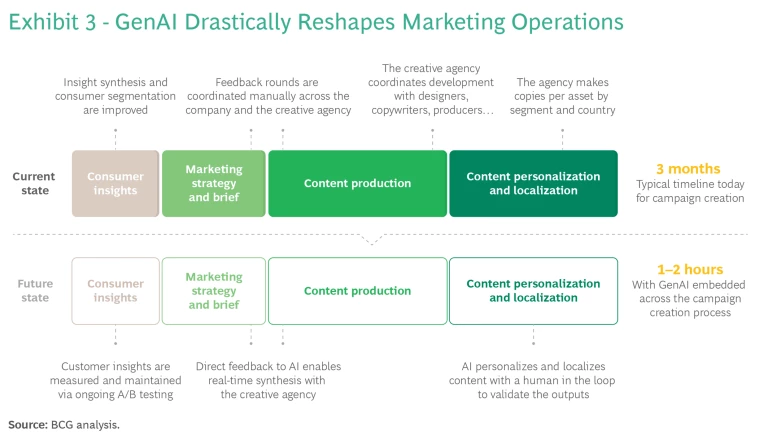
We know personalization is effective. In our work with a major automaker, campaigns that integrated customer preferences (for example, the time since last purchase, a sedan to a sedan customer, a lease offer to a lease customer) saw conversion rates grow by 1.9 times. After we further personalized the campaign to incorporate known preferences for a specific model, trim, color, and offer type, conversion rose by an additional 3.3 times. These changes were executed in weeks and then realized continuously. They built on and automated months of marketing effort and tied into the ongoing content creation of the marketing agency.
Customer Self-Assist—Boosting Lifetime Value with GenAI-Enabled Chatbots. Most brands use tools such as chat to handle support and steer customers to their next-best action in the process toward conversion. But what they’d rather do is drive customer lifetime value higher. Achieving that aspiration, however, requires deep data integration and real-time feedback loops. GenAI enables both. Unlike traditional chat, which generally draws from static, predefined scripts, GenAI-supported ChatUX interfaces pull continually from fresh customer data, learn from past interactions, and engage with individuals in deeply contextual ways. (See Exhibit 4.) Marketers can train the interface to serve as a concierge—providing rich connections across journey stages that deliver consistent, high-touch experiences. The data gained from these interactions can produce significant value as well, surfacing insights that can be funneled back into the customer experience organization.
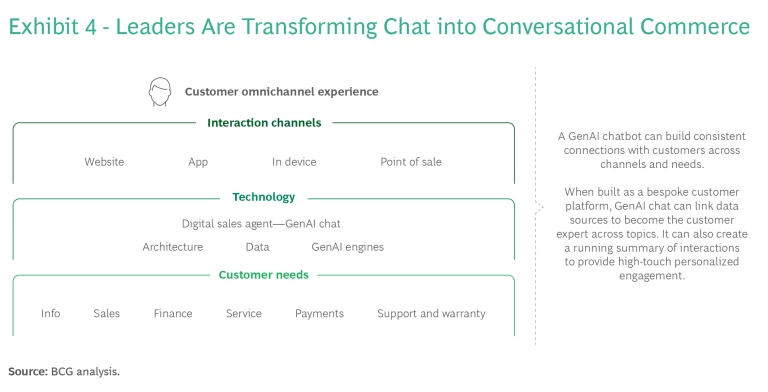
An automotive original equipment manufacturer increased its system usability scale score by 13 points after it introduced a GenAI-enabled ChatUX system. The company was able to leverage prior investments in machine-learning capabilities to speed the implementation, allowing it to get the new system up and ready to go live in about nine weeks.
Employee Assist—Unleashing Faster, Better, and Cheaper Issue Resolution. Troubleshooting and dispute resolution might seem unglamorous. But customers who feel cared for—who believe their issues are taken seriously, addressed competently, and resolved quickly—are much more likely to stay loyal. Providing that degree of care, consistently, across a variety of issues and around the clock is expensive and logistically complex. GenAI can cut costs and streamline care in two ways: by addressing issue resolution more responsively than before and by helping human sales reps be more effective.
For example, one B2B technology company is using GenAI as a predictive, proactive customer care agent. When an issue is detected, the system automatically triggers GenAI-enabled outreach to the customer, in many cases before the individual even realizes there is a problem. The GenAI agent then works with the customer to troubleshoot in real time, often resolving the issue then and there. The system has saved on training and staffing. And it has delivered much better customer results, allowing the company to manage a higher volume of inquiries faster than before.
GenAI can support sales reps across the marketing funnel, especially in situations where more human interaction is needed. For example, another B2B technology company is using GenAI to help its sales team improve customer outreach and reduce administrative work. Sales reps can enter a customer’s name into a GenAI dashboard and click “generate email.” The platform bundles customer data, then applies pretrained learning models to create targeted messaging contoured to specific customers and their service and buying histories. The platform can help reps answer product and billing queries and enable renewal outreach. In the three months since launching the GenAI system, the sales organization has boosted net revenue retention by 12%, improved productivity by 50%, and cut outbound calls by 40%.
Walk Before You Run with GenAI
GenAI is best understood as part of a progression of customer experience capabilities that organizations need to master. It is the newest tool to emerge—and potentially the most transformative—but to use it effectively, companies need to know their customers deeply and have mechanisms in place that allow them to capture and refresh this knowledge continually. Otherwise, as with any disruptive technology, GenAI can easily become a sinkhole for time, talent, and cost if companies haven’t laid the groundwork first.
That foundation consists of
a paradigm we call MIDAS
, so named because it allows companies to deliver high-quality customer experiences in a repeatable, systemic, and scalable fashion across touch points. The five elements that make up this model are:
- Measuring for Impact. Traditionally, companies have relied on surveys and other forms of post facto measurement to sense shifts in customer behaviors and gauge their impact, but the customer experience bar has long since risen. Analytical engines capable of monitoring interactions at the individual customer journey level are now table stakes. GenAI use cases depend on these systems being in place, since the outputs from them are essential to inform subsequent messaging and interactions.
- Innovating Customer Experience Boldly. Customer experience leaders enable continual exploration, ideation, as well as testing and learning. Human-centered design practices can give companies a leg up in applying GenAI—allowing them to pinpoint how the technologies can create more personalized experiences. Our research shows that design-centric companies command five times greater customer loyalty than other businesses.
- Delivering Journeys Front to Back. Deep integration is essential to create interactions that delight customers and keep them coming back. Customer experience leaders pool talent and funding from across the company to create multifunctional teams focused on delivering superior customer outcomes. The coordination makes it easier and faster for organizations to deploy GenAI.
- Activating a Customer-First Culture. Rather than simply talking about putting customers first, customer experience leaders activate this mindset by designing performance measures and reward systems that inculcate desired behaviors and creating formal and informal mechanisms that foster dialogue between senior executives and front-line leaders. This culture needs to be in place to define high-impact GenAI applications and deliver meaningful customer outcomes.
- Synchronizing Across Channels. GenAI experiences break down if they speak for only part of the business. To deliver the seamless, personalized interactions that customers expect across touch points, companies have to enable the necessary underlying connectivity. This synchronization requires centralized omnichannel data on customers and automated analytics, usually powered by AI. (See “Know When to Apply AI Versus Generative AI.”)
Having laid these foundations, companies can begin reaping the benefits of GenAI.
Know When to Apply AI Versus Generative AI
There are also occasions when hybrid approaches make sense—such as when a business wants to assess patterns in typical consumer fraud behaviors while trying to imagine new ways in which fraud might be committed.
How to Start the GenAI Conversation in Your Organization
We believe GenAI will be a game changer that can help rewrite the economics of customer experience. In the right hands, it will lower the cost of insights acquisition, amplify the productivity of human sales teams, and allow companies to individualize outreach at scale. Given the potential, organizations need to begin having conversations with their leadership now and start crafting a plan that helps them take advantage of what this tool has to offer based on their current capabilities.
Here are some thoughts to help guide those discussions:
- Start small, think big. Leaders should prioritize one or two use cases and move forward decisively. Assembling cross-functional teams and employing a test-and-learn agenda is essential to realizing value and using GenAI to create advantage. As some of the examples covered earlier in the article show, leaders aren’t waiting around. They are using GenAI to improve personalization, enrich chatbot interactions, and revamp customer support.
- Develop longer-term improvements in parallel. Most businesses will need to strengthen their data infrastructure, invest in bedrock AI applications, and integrate precision-marketing processes. These improvements will require ongoing investment, but leaders should advance near-term use case priorities while implementing longer-term improvements in parallel, acquiring the capabilities they need and building upon them as they go.
- Enable an adaptive culture. Use cases involving GenAI and related advances require rapid, ongoing adaptation. Companies need to prepare their organizations to be equally responsive. Agile practices, cross-functional teams, and proactive planning can help leaders anticipate important shifts early. This is the time for companies to begin designing a GenAI-enabled future and consider the investments, resource alignment, and capability development that will allow them to be as nimble as the GenAI tools they are hoping to leverage.

